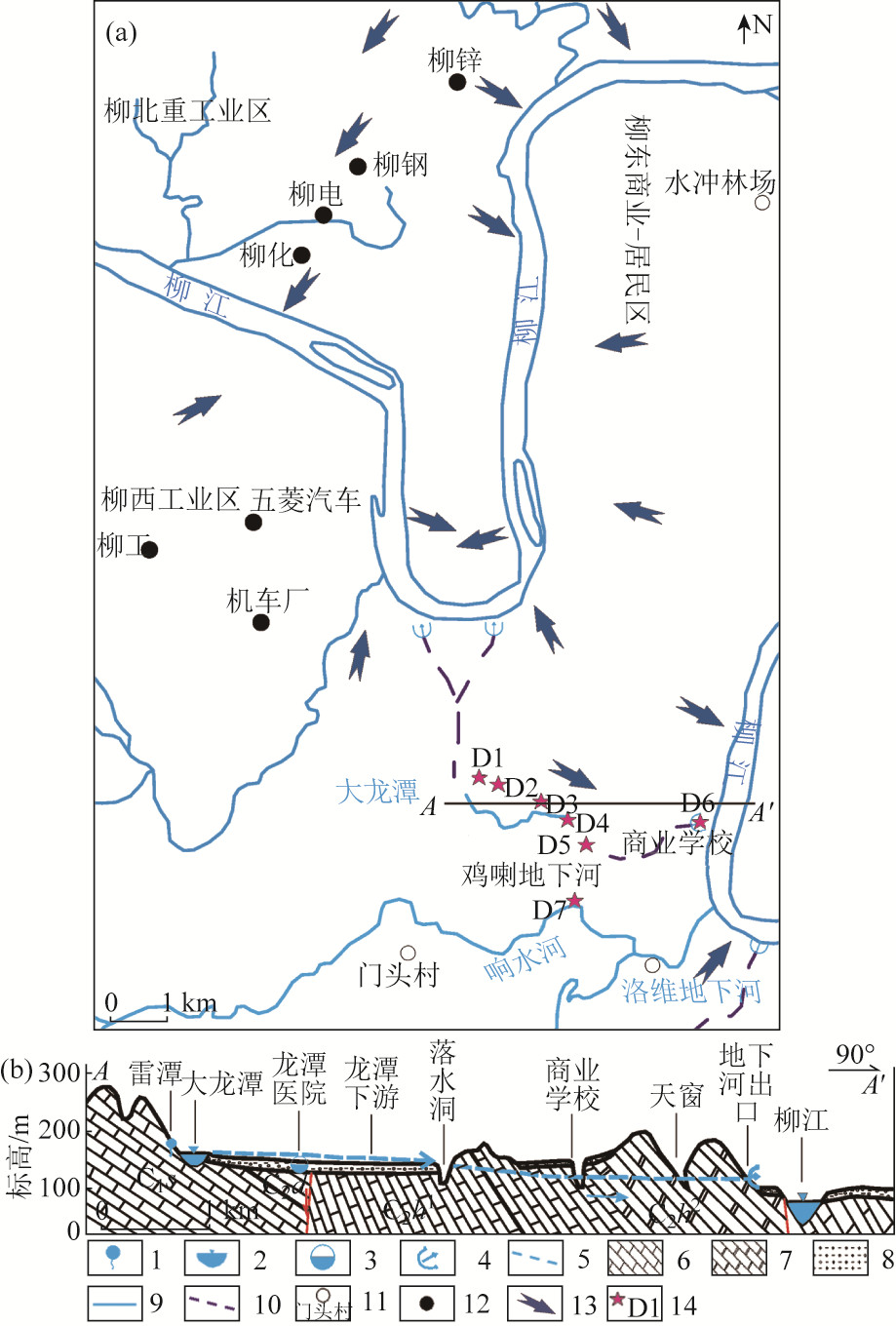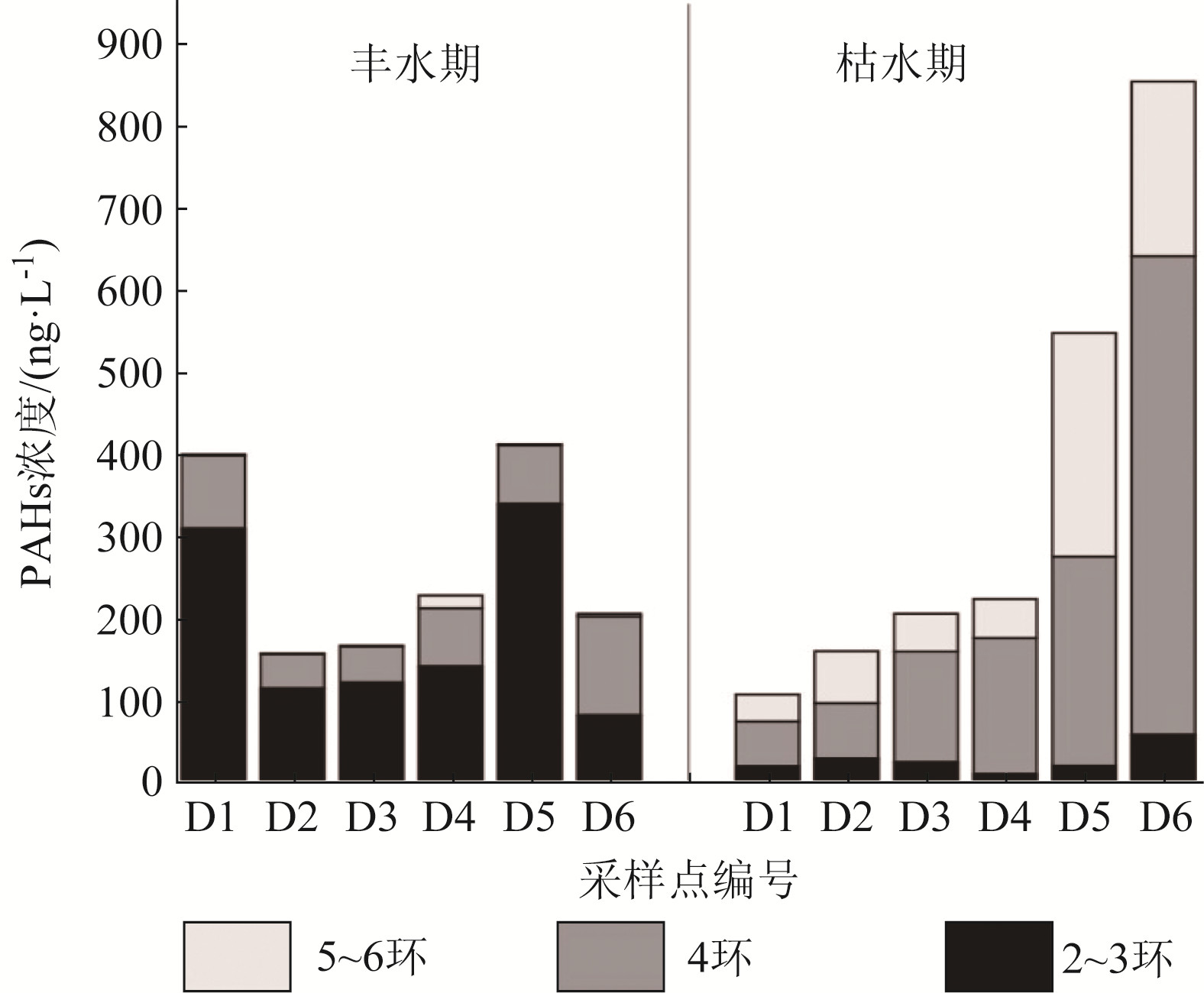Pollution characteristic and health risk assessment of polycyclic aromatic hydrocarbons in karst underground river of heavy industrial city
-
摘要:
重工业城市是多环芳烃(polycyclic aromatic hydrocarbons, PAHs)的重要污染源体,岩溶区因其独特的地下空间结构, 导致PAHs在岩溶环境中能长期存在,危害岩溶生态系统和人类健康。为揭示重工业城市岩溶地下河中PAHs的污染特征,于2015年6月(丰水期)和12月(枯水期),采集鸡喇地下河管道沿走向布设的6个采样点,枯水期增加1个响水河采样点。结果表明: ①丰、枯水期地下水中ΣPAHs平均浓度分别为267.32 ng/L和350.59 ng/L,且丰水期PAHs组成以2~3环为主,枯水期以4环为主,其组成表现出受降雨以及各组分理化性质的影响; ②鸡喇地下河受到了柳北重工业的影响,其PAHs污染水平为中等; ③健康风险评价结果显示仅枯水期部分风险指数高于5.0×10-5,尤其是幼儿阶段超标率较高,表明PAHs对居民身体健康具有一定的危害,但危害不大; ④通过对鸡喇地下河中PAHs的后续追踪,发现鸡喇地下河中PAHs的浓度近些年处于较稳定的状态。研究PAHs在岩溶区重工业城市多环境介质中的环境行为,防治PAHs对岩溶环境的污染,既是环境科学研究的一项重要内容,又可为岩溶地区工业布局和城市规划提供科技支撑。
Abstract:The heavy industrial city is an important source of polycyclic aromatic hydrocarbons (PAHs) pollution. PAHs can exist in karst environment for a long time due to its unique underground space structure, which harms the karst ecosystem and human health. In order to reveal the characteristics of PAHs pollution in karst underground river in heavy industrial city, the researchers in this paper collected 6 sampling sites in Jila underground river pipeline strike in June (wet season) and December (dry season) in 2015, and added 1 sampling site in Xiangshui River during dry season. The results are as follows. ① The average concentrations of ΣPAHs in groundwater in wet reason and dry season were 267.32 ng/L and 350.59 ng/L, respectively. The PAHs were mainly composed of 2~3 rings in wet season and 4 rings in dry season, which were influenced by rainfall and physicochemical properties of each component. ② Jila underground river was affected by Liubei heavy industry, and its PAHs pollution level was medium. ③ The results of health risk assessment showed that only part of the risk index in dry season was higher than 5.0×10-5, especially in the early childhood stage, indicating that PAHs had certain harm to the residents' health, but the harm was not great. ④ Through the follow-up tracking of PAHs in Jila underground river, it was found that the PAHs concentration in Jila underground river was in a relatively stable state in recent years. The environmental behavior research of PAHs in the multi-environmental media of heavy industrial cities and prevention of PAHs pollution to karst environment is not only an important content of environmental science research, but also provides scientific and technological support for industrial layout and urban planning in karst areas.
-

-
表 1 柳州市鸡喇地下河采样点概况
Table 1. Sampling sites of Jila underground river in Liuzhou City
采样点编号 水点类型 周边环境 D1 泉点 泉点出露于山脚下,位于公园内 D2 水潭 泉水汇成长约800 m、宽约200 m、水深3~5 m的水潭,称为大龙潭 D3 地下河管道 采样点位于龙潭医院石山中的洞穴中,是地下河流经的管道 D4 地表河 周围为居民区和农田,有生活污水和灌溉水排入 D5 伏流入口 位于商业学校内 D6 地下河出口 位于柳江边,周围有大量小型工厂 D7 地表河 周围为农田、公路 表 2 鸡喇地下河中PAHs终生致癌风险指数
Table 2. Lifetime carcinogenic risk index of PAHs in Jila underground river
点位 PAHs终生致癌风险指数 终生 婴儿 幼儿 儿童 青少年 成人 丰水期 D1 2.77×10-6 9.71×10-7 6.84×10-7 5.18×10-7 7.17×10-7 5.66×10-6 D2 1.14×10-6 3.99×10-7 2.81×10-7 2.13×10-7 2.95×10-7 2.33×10-6 D3 1.39×10-6 4.86×10-7 3.42×10-7 2.59×10-7 3.59×10-7 2.83×10-6 D4 1.27×10-5 4.45×10-6 3.13×10-6 2.37×10-6 3.28×10-6 2.59×10-5 D5 1.66×10-6 5.80×10-7 4.09×10-7 3.10×10-7 4.28×10-7 3.38×10-6 D6 3.63×10-6 1.27×10-6 8.96×10-7 6.79×10-7 9.39×10-7 7.42×10-6 枯水期 D1 2.86×10-5 1.00×10-5 7.05×10-6 5.34×10-6 7.39×10-6 5.84×10-5 D2 5.26×10-5 1.84×10-5 1.30×10-5 9.83×10-6 1.36×10-5 1.07×10-4 D3 4.50×10-5 1.58×10-5 1.11×10-5 8.41×10-6 1.16×10-5 9.19×10-5 D4 4.83×10-5 1.69×10-5 1.19×10-5 9.04×10-6 1.25×10-5 9.88×10-5 D5 2.23×10-4 7.83×10-5 5.52×10-5 4.18×10-5 5.78×10-5 4.57×10-4 D6 1.92×10-4 6.74×10-5 4.74×10-5 3.59×10-5 4.97×10-5 3.93×10-4 D7 6.37×10-5 2.23×10-5 1.57×10-5 1.19×10-5 1.65×10-5 1.30×10-4 -
[1] 蓝家程. 岩溶地下河系统中多环芳烃的迁移、分配及生态风险研究[D]. 重庆: 西南大学, 2014.
Lan J C. Study on Migration, Partitioning and Ecological Risk of PAHs in a Karst Underground River System in Southwest China[D]. Chongqing: Southwest University, 2014.
[2] 袁道光, 蔡桂鸿. 岩溶环境学[M]. 重庆: 重庆出版社, 1988.
Yuan D G, Cai G H. Karst Environment[M]. Chongqing: Chongqing Press, 1988.
[3] 蓝家程, 孙玉川, 师阳, 等. 岩溶地下河流域表层土壤多环芳烃污染特征及来源分析[J]. 环境科学, 2014, 35(8): 2937-2943.
Lan J C, Sun Y C, Shi Y, et al. Source and contamination of polycyclic aromatic hydrocarbons in surface soil in karst underground river basin[J]. Environmental Science, 2014, 35(8): 2937-2943.
[4] Ford D, Williams P. Karst Hydrogeology and Geomorphology[M]. Chichester: John Wiley & Sons, 2007.
[5] Chen L G, Ran Y, Xing B S, et al. Contents and sources of polycyclic aromatic hydrocarbons and organochlorine pesticides in vegetable soils of Guangzhou, China[J]. Chemosphere, 2005, 60(7): 879-890. doi: 10.1016/j.chemosphere.2005.01.011
[6] Christensen E R, Arora S. Source apportionment of PAHs in sediments using factor analysis by time records: Application to Lake Michigan, USA[J]. Water Research, 2007, 41(1): 168-176. doi: 10.1016/j.watres.2006.09.009
[7] 匡少平, 孙东亚. 多环芳烃的毒理学特征与生物标记物研究[J]. 世界科技研究与发展, 2007, 29(2): 41-47.
Kuang S P, Sun Y D. Toxicological characteristics and biomarkers of polycyclic aromatic hydrocarbons (PAHs)[J]. World Sci-Tech R & D, 2007, 29(2): 41-47.
[8] 孔祥胜, 祁士华, Oramah I T, 等. 广西大石围天坑群地下河水中多环芳烃的污染特征[J]. 环境科学, 2011, 32(4): 1081-1087.
Kong X S, Qi S H, Oramah I T, et al. Contamination of polycyclic aromatic hydrocarbons in surface water in underground river of Dashiwei Tiankeng Group in Karst Area, Guangxi[J]. Environmental Science, 2011, 32(4): 1081-1087.
[9] 王喆, 李江, 卢丽, 等. 清水泉地下河多环芳烃来源及分配动态[J]. 中国岩溶, 2023, 42(2): 257-265.
WANG Z, LI J, LU L, et al. Dynamic research on source and distribution of PAHs in the Qingshuiquan underground river[J]. Carsologica Sinica, 2023, 42(2): 257-265.
[10] Chen W, Zhang Z Q, Zhu Y, et al. Distribution, sources and transport of polycyclic aromatic hydrocarbons (PAHs) in karst spring systems from Western Hubei, Central China[J]. Chemosphere, 2022, 300: 134502. doi: 10.1016/j.chemosphere.2022.134502
[11] Wu X, Gao X B, Tan T, et al. Sources and pollution path identification of PAHs in karst aquifers: An example from Liulin karst water system, northern China[J]. Journal of Contaminant Hydrology, 2021, 241: 103810. doi: 10.1016/j.jconhyd.2021.103810
[12] Lan J C, Sun Y C, Xiao S Z, et al. Polycyclic aromatic hydrocarbon contamination in a highly vulnerable underground river system in Chongqing, Southwest China[J]. Journal of Geochemical Exploration, 2016, 168: 65-71. doi: 10.1016/j.gexplo.2016.05.013
[13] 庞国涛, 阎琨, 李伟. 广西三娘湾海域表层沉积物多环芳烃特征及风险评价[J]. 中国地质调查, 2021, 8(5): 95-100. http://zgdzdc.xml-journal.net/cn/article/doi/10.19388/j.zgdzdc.2021.05.11
Pang G T, Yan K, Li W. Characters and risk assessment of hydrocarbons in surface sediments of Sanniang Bay in Guangxi Province[J]. Geological Survey of China, 2021, 8(5): 95-100. http://zgdzdc.xml-journal.net/cn/article/doi/10.19388/j.zgdzdc.2021.05.11
[14] Chang J, Zhang E L, Liu E F, et al. A 60-year historical record of polycyclic aromatic hydrocarbons (PAHs) pollution in lake sediment from Guangxi Province, Southern China[J]. Anthropocene, 2018, 24: 51-60. doi: 10.1016/j.ancene.2018.11.003
[15] Hu T P, Shi M M, Mao Y, et al. The characteristics of polycyclic aromatic hydrocarbons and heavy metals in water and sediment of Dajiuhu subalpine wetland, Shennongjia, central China, 2018-2020: Insights for sources, sediment-water exchange, and ecological risk[J]. Chemosphere, 2022, 309: 136788. doi: 10.1016/j.chemosphere.2022.136788
[16] 孙玉川, 沈立成, 袁道先. 表层岩溶带土壤中多环芳烃分布特征及来源解析[J]. 中国岩溶, 2013, 32(1): 79-87.
Sun Y C, Shen L C, Yuan D X. Distributing features and source analysis of polycyclic aromatic hydrocarbons in epikarst soils[J]. Carsologica Sinica, 2013, 32(1): 79-87.
[17] Sun Y C, Zhang S Y, Lan J C, et al. Vertical migration from surface soils to groundwater and source appointment of polycyclic aromatic hydrocarbons in epikarst spring systems, southwest China[J]. Chemosphere, 2019, 230: 616-627. doi: 10.1016/j.chemosphere.2019.05.007
[18] 叶凯, 孙玉川, 朱琳跃, 等. 典型岩溶槽谷区不同地表覆被土壤中多环芳烃的运移特征和来源解析[J]. 环境科学学报, 2021, 41(12): 5127-5136.
Ye K, Sun Y C, Zhu L Y, et al. Migration characteristic and source analysis of PAHs in soils with different surface cover in typical karst trough valley area[J]. Aclta Scientiae Circumstantiae, 2021, 41(12): 5127-5136.
[19] 李晓丽, 孙玉川, 胡雨晴, 等. 岩溶区地下河多环芳烃多年变化及其对大气污染物响应特征[J]. 环境污染与防治, 2022, 44(7): 895-899, 906.
Li X L, Sun Y C, Hu Y Q, et al. Multi-year variation of polycyclic aromatic hydrocarbons in karst underground river and its response characteristics to atmospheric pollutants[J]. Environmental Pollution & Control, 2022, 44(7): 895-899, 906.
[20] 苗迎, 孔祥胜, 李成展. 重工业区空气和大气干湿沉降物中多环芳烃的污染特征[J]. 桂林理工大学学报, 2018, 38(4): 732-737.
Miao Y, Kong X S, Li C Z. Pollution characteristics of polycyclic aromatic hydrocarbons in the air and atmospheric deposition of heavy industrial district[J]. Journal of Guilin University of Technology, 2018, 38(4): 732-737.
[21] 孔祥胜, 苗迎, 栾日坚, 等. 重工业区高脆弱岩溶含水层中多环芳烃污染的初步研究[J]. 中国岩溶, 2015, 34(4): 331-340.
Kong X S, Miao Y, Luan R J, et al. Preliminary study on contaminant of polycyclic aromatic hydrocarbons in vulnerable karst aquifer in a heavy industry district[J]. Carsologica Sinica, 2015, 34(4): 331-340.
[22] 柳州市区域环境水文地质调查报告(比例尺1∶ 50 000~1∶ 100 000)[R]. 南宁: 广西壮族自治区地质矿产局, 1990.
Survey Report of Environment and Hydrogeology in Liuzhou (1∶ 50 000~1∶ 100 000)[R]. Nanning: Bureau of Geology and Mineral Prospecting and Exploitation of Guangxi Zhuang Autonomous Region, 1990.
[23] 昌盛, 耿梦娇, 刘琰, 等. 滹沱河冲洪积扇地下水中多环芳烃的污染特征[J]. 中国环境科学, 2016, 36(7): 2058-2066.
Chang S, Geng M J, Liu Y, et al. Pollution characteristic of polycyclic aromatic hydrocarbons in the groundwater of Hutuo River Pluvial Fan[J]. China Environmental Science, 2016, 36(7): 2058-2066.
[24] 王文岩, 张娟, 李雪芳, 等. 西安城郊水体中多环芳烃污染特征及来源辨析[J]. 干旱地区农业研究, 2015, 33(5): 201-206.
Wang W Y, Zhang J, Li X F, et al. Characteristics and sources of polycyclic aromatic hydrocarbons pollution in water of Xi'an outskirt regions[J]. Agricultural Research in the Arid Areas, 2015, 33(5): 201-206.
[25] 龚香宜, 何炎志, 孙云雷. 江汉平原四湖流域上区地下水中多环芳烃分布特征与源解析[J]. 环境科学学报, 2015, 35(3): 789-796.
Gong X Y, He Y Z, Sun Y L. Distribution and source of polycyclic aromatic hydrocarbons in groundwater in the upper region of Sihu Lake Basin from Jianghan Plain[J]. Acta Scientiae Circumstantiae, 2015, 35(3): 789-796.
[26] 杜士林, 丁婷婷, 董淮晋, 等. 沙颍河流域水环境中多环芳烃污染及风险评价[J]. 农业环境科学学报, 2020, 39(3): 601-611.
Du S L, Ding T T, Dong H J, et al. Pollution and ecological risk assessment of polycyclic aromatic hydrocarbons in the water environment of Shaying River Basin, China[J]. Journal of Agro-Environment Science, 2020, 39(3): 601-611.
[27] 高佳佳, 罗维. 洋河流域环境多介质中多环芳烃(PAHs)的长距离迁移潜力[J]. 农业环境科学学报, 2017, 36(8): 1601-1609.
Gao J J, Luo W. Analysis of long-range transport potential (LRTP) of polycyclic aromatic hydrocarbons (PAHs) in environments of the Yanghe Watershed[J]. Journal of Agro-Environment Science, 2017, 36(8): 1601-1609.
[28] 孙玉川. 有机氯农药和多环芳烃在表层岩溶系统中的迁移、转化特征研究[D]. 重庆: 西南大学, 2012.
Sun Y C. Study on Migration and Transformation Characteristics of OCPs and PAHs in Epikarst System[D]. Chongqing: Southwest University, 2012.
[29] 王尊波, 孙玉川, 梁作兵, 等. 重庆青木关地下河流域水中多环芳烃的污染和迁移特征[J]. 环境科学学报, 2016, 36(3): 812-819.
Wang Z B, Sun Y C, Liang Z B, et al. Contamination and migration of polycyclic aromatic hydrocarbons in water of Qingmuguan karst underground river catchment in Chongqing, China[J]. Acta Scientiae Circumstantiae, 2016, 36(3): 812-819.
[30] 孔祥胜, 祁士华. 典型岩溶区多介质中多环芳烃的环境存在特征——以广西大石围天坑群为例[J]. 中国岩溶, 2013, 32(2): 182-188.
Kong X S, Qi S H. The existing conditions of PAHs in multimedium in typical karst area: A case in the Leye Tiankeng Group, Guangxi[J]. Carsologica Sinica, 2013, 32(2): 182-188.
[31] 王潇媛, 郭纯青, 裴建国, 等. 清水泉岩溶地下水中多环芳烃污染特征及来源[J]. 南水北调与水利科技, 2015, 13(2): 274-278.
Wang X Y, Guo C Q, Pei J G, et al. Pollution characteristics and source analysis of PAHs in the karst groundwater of Qingshui Spring[J]. South-to-North Water Transfers and Water Science & Technology, 2015, 13(2): 274-278.
[32] Ma W L, Liu L Y, Qi H, et al. Polycyclic aromatic hydrocarbons in water, sediment and soil of the Songhua River Basin, China[J]. Environmental Monitoring and Assessment, 2013, 185(10): 8399-8409.
[33] 耿梦娇, 昌盛, 刘琰, 等. 滹沱河冲洪积扇深层孔隙水中多环芳烃和酞酸酯的污染水平与饮水健康风险评估[J]. 中国环境科学, 2016, 36(12): 3824-3830.
Geng M J, Chang S, Liu Y, et al. Pollution status and health risks of drinking water of the polycyclic aromatic hydrocarbons and phthalate esters in the deep shallow pore water of Hutuo River Pluvial Fan[J]. China Environmental Science, 2016, 36(12): 3824-3830.
[34] United States Environmental Protection Agency. The Risk Assessment Guidelines of 1986[R]. Washington: Office of Health and Environmental Assessment, 1986.
[35] 环境保护部. 中国人群暴露参数手册(成人卷)[M]. 北京: 中国环境出版社, 2013: 12.
Ministry of Environmental Protection. Exposure Factors Handbook of Chinese Population[M]. Beijing: China Environmental Science Press, 2013: 12.
[36] Nisbet I C T, LaGoy P K. Toxic Equivalency Factors (TEFs) for polycyclic aromatic hydrocarbons (PAHs)[J]. Regulatory Toxicology and Pharmacology, 1992, 16(3): 290-300.
[37] Suman S, Sinha A, Tarafdar A. Polycyclic aromatic hydrocarbons (PAHs) concentration levels, pattern, source identification and soil toxicity assessment in urban traffic soil of Dhanbad, India[J]. Science of The Total Environment, 2016, 545-546: 353-360.
[38] 罗庆, 孙丽娜, 张耀华. 细河流域地下水中多环芳烃污染健康风险评价[J]. 农业环境科学学报, 2011, 30(5): 959-964.
Luo Q, Zhang L N, Zhang Y H. Health risk assessment of polycyclic aromatic hydrocarbons in groundwater from Xihe River Area, China[J]. Journal of Agro-Environment Science, 2011, 30(5): 959-964.
[39] Sun J H, Wang G L, Chai Y, et al. Distribution of polycyclic aromatic hydrocarbons (PAHs) in Henan Reach of the Yellow River, Middle China[J]. Ecotoxicology and Environmental Safety, 2009, 72(5): 1614-1624.
-




 下载:
下载:
